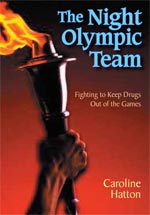As a scientist (I'm a pharmacist and analytical chemist), I’ve been at three Olympics, working on the lab team. We test athletes’ samples for performance-enhancing drugs that are prohibited because taking them is doping. It’s cheating, it can be dangerous to health, and it’s contrary to the spirit of sports. The most talked-about doping agents are anabolic steroids, but there are many more.
Red blood cells
Blood doping is prohibited in many sports
At the 2002 Winter Olympics in Salt Lake City, we were testing samples night after night. We never knew what would happen next. Any sample could contain a drug. Reporting it would get the athlete punished.
After we did find a drug in a sample, we spent hours double checking, asking ourselves, “How can we be sure that the test result is correct?” Lots of what if exercises and discussions.
Drawing of a molecule of EPO.
EPO is a blood-booster drug prohibited in sport.
That night, ideas were flying around like sparks between four of us. The rush of excitement made me leap off my chair and pace all over the room, feeling ready to burst. I was thrilled—as a scientist and as a writer. That’s when I thought, “Some day, I will write this story for young readers.”
So I did! I wrote an article, “The Night Olympic Team.” Cricket magazine published it first, then The School Magazine in Australia and YES Mag, the Canadian science magazine for young readers.
And just as I was finally getting this longer version done, a doubt surfaced in my mind. This doubt turned out to be a good question.
Which would be better? A longer book including key players’ profiles or a shorter book without them?
This was the most important decision I faced while writing the book.
The longer book would let readers dig deeper. The shorter book would be quicker and easier to read. My writing buddies, as well as famous author Caroline Arnold all agreed that a shorter book would appeal to more readers.
I decided to shorten the book. I couldn’t simply go back to the article version, which filled only five magazine pages. A book needed some details about the key players’ roles and background. After spending a year and a half writing the long version, it took me only two weeks to shorten it.
How exactly did I do it? I spread the pages on the floor and crossed out the characters’ profiles with a big marker. Then I entered the changes in my Word file and reprinted it. The next day, I read what I got. It felt like reading the bare bones of the story, like sitting down for a meal but being served only the bones of a fish. I had cut way too much. What to do? Add bits and pieces back in one by one, or start over?
I started all over. This time I cut more gingerly, down to half of the original length. Then I split the story into nine chapters.
Next came the most fun part: writing the transitions between chapters! Each chapter ends at a place that leaves readers wanting to know what happens next. Each chapter then has a fact box packed with extra info. I needed to make sure that when readers turned the page and began to read the next chapter, they would know where they were in the story. Writers must figuratively take readers by the hand and never let go, so they don’t get lost. The first sentence of chapters 2 to 9 takes care of that. Those sentences were the last thing I wrote. Perhaps it was the most fun because it was quick and easy. Perhaps it was because the book was finally done, done, done!
And that’s the version that was published with minor changes.
This post is adapted from part of an interview of mine by Beckie Weinheimer, author of the novel, Converting Kate.
Caroline Hatton and Beckie Weinheimer
LINKS
• Book writers often cut big chunks out of manuscripts to shape their books. Those parts can become short stories or articles in magazines, chapters in new books, or blog posts. Three profiles that I cut from The Night Olympic Team are posted at this blog, to show glimpses of the childhoods and career paths of key players in the book: click here, here or here to read them.
• For a ton of links about science writing, scroll down to LINKS AND MORE after you click here.





No comments:
Post a Comment